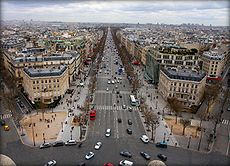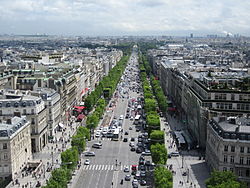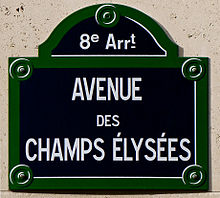- Champs-Élysées
-
8e ArrtAVENUE
des
CHAMPS-ÉLYSÉESArrondissement 8th Quarter Champs-Élysées. Faubourg du Roule. Begins Place de la Concorde Ends Place Charles de Gaulle Length 1910 m Width 70 m Creation 1670 Denomination 2 March 1864 The Avenue des Champs-Élysées (French pronunciation: [avəˈny de ˈʃɑ̃z‿eliˈze] (
 listen)) is a prestigious avenue in Paris, France. With its cinemas, cafés, luxury specialty shops and clipped horse-chestnut trees, the Avenue des Champs-Élysées is one of the most famous streets and one of the most expensive strip of real estate in the world[1]. The name is French for Elysian Fields, the place of the blessed dead in Greek mythology. The Avenue des Champs-Élysées is known as "The most beautiful avenue of the world", La plus belle avenue du monde in French.[2]
listen)) is a prestigious avenue in Paris, France. With its cinemas, cafés, luxury specialty shops and clipped horse-chestnut trees, the Avenue des Champs-Élysées is one of the most famous streets and one of the most expensive strip of real estate in the world[1]. The name is French for Elysian Fields, the place of the blessed dead in Greek mythology. The Avenue des Champs-Élysées is known as "The most beautiful avenue of the world", La plus belle avenue du monde in French.[2]Contents
Description
The avenue runs for 1.91 km (1.18 mi) through the 8th arrondissement in northwestern Paris, from the Place de la Concorde in the east, with the Obelisk of Luxor,[3] to the Place Charles de Gaulle (formerly the Place de l'Étoile) in the west, location of the Arc de Triomphe. The Champs-Élysées forms part of the Axe historique.
One of the principal tourist destinations in Paris, the lower part of the Champs-Élysées is bordered by greenery (Carré Marigny) and by buildings such as the Théâtre Marigny and the Grand Palais (containing the Palais de la Découverte). The Élysée Palace is slightly to the north, but not on the avenue itself. Further to the west, the avenue is lined with cinemas, cafés and restaurants, and luxury specialty shops. The Champs-Élysées ends at the Arc de Triomphe, built by Napoleon Bonaparte to honour his victories.
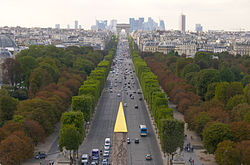 The historical axis, looking west from Place de la Concorde (the Obelisk of Luxor is in the foreground).
The historical axis, looking west from Place de la Concorde (the Obelisk of Luxor is in the foreground).
History
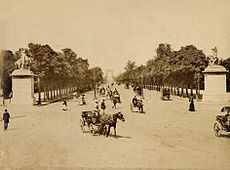 The Champs-Élysées in 1890, viewed from the Place de la Concorde.
The Champs-Élysées in 1890, viewed from the Place de la Concorde.
 Statue of Napoléon Bonaparte erected at Champs-Élysées in 1852, soon after the coronation of Napoleon III.
Statue of Napoléon Bonaparte erected at Champs-Élysées in 1852, soon after the coronation of Napoleon III.
 The Free French 2nd Armored Division marches down the Champs-Élysées on 26 August 1944 to celebrate the Liberation of Paris.
The Free French 2nd Armored Division marches down the Champs-Élysées on 26 August 1944 to celebrate the Liberation of Paris.
The Champs-Élysées was originally fields and market gardens, until 1616, when Marie de Medici decided to extend the axis of the Tuileries Garden with an avenue of trees. As late as 1716, Guillaume Delisle's map of Paris shows that a short stretch of roads and fields and market garden plots still separated the grand axe of the Tuileries gardens from the planted "Avenue des Thuilleries," which was punctuated by a circular basin where the Rond-point des Champs-Élysées stands today; already it was planted with some avenues of trees to the Seine river through woods and fields. In 1724, the Tuileries Garden axis and the avenue were connected and extended, leading beyond the Place de l'Étoile; the "Elysian Fields" were open parkland flanking it, soon filled in with bosquets of trees formally planted in straight rank and file. To the east, the unloved and neglected "Vieux Louvre" (as it is called on the maps), still hemmed in by buildings, was not part of the axis. In a map of 1724, the Grande Avenue des Champs-Elisée stretches west from a newly-cleared Place du Pont Tournant soon to be renamed for Louis XV and now the Place de la Concorde. By the late 18th century, the Champs-Élysées had become a fashionable avenue; the bosquet plantings on either side had thickened enough to be given formal rectangular glades (cabinets de verdure). The gardens of houses built along the Faubourg Saint-Honoré backed onto the formal bosquets. The grandest of them was the Élysée Palace. A semicircle of house-fronts now defined the north side of the Rond-Point. Queen Marie Antoinette drove with her friends and took music lessons at the grand Hôtel de Crillon on the Place Louis XV.[4] The avenue from the Rond-Point to the Étoile was built up during the Empire. The Champs-Élysées itself became city property in 1828, and footpaths, fountains, and gas lighting were added. Over the years, the avenue has undergone numerous transitions, most recently in 1994, when the sidewalks were widened.
The Avenue des Champs-Élysées, because of its size and proximity to several Parisian landmarks such as the Arc de Triomphe, has been the site of several notable military parades, the most infamous being the march of German troops celebrating the Fall of France on 14 June 1940, and the two most famous, the subsequent marches of Free French and American forces after the liberation of the city, respectively, the French 2nd Armored Division on 26 August 1944, and the US 28th Infantry Division on 29 August 1944.
Premier offices and retail
In 1860, the merchants along the avenue joined together to form the Syndicat d'Initiative et de Défense des Champs-Élysées, changed to an association in 1916 to promote commercially the avenue. In 1980, the group changed its name to the Comité des Champs-Élysées and to "Comité Champs-Élysées" in 2008. It is the oldest standing committee in Paris. The committee has always dedicated itself to seek public projects to enhance the avenue's unique atmosphere, and to lobby the authorities for extended business hours and to organize special events. Today, the committee in coordination with other professional organisations could review with the Parisian administration over the addition of new business which size is over 1000 square meters to the avenue.
Because of the high rents, few people live on the Champs-Élysées; the upper stories tend to be occupied by offices. Rents are particularly high on the north side of the avenue, because of better exposure to sunlight. The baroque-influenced regular architecture of the grandiose Champs-Élysées is typical of the Haussmann boulevard architecture of the Second Empire and Third Republic. The avenue is located right next to the Palais de l'Élysée, the presidential palace, with its rounded gate, and the Grand Palais, erected in the late 19th century. While walking among the gardens and tree-lined promenades one can even encounter an open-air marionette theatre for children, a French tradition popular through the ages.
The avenue is also one of the most famous streets in the world for upscale shopping. Adidas, Benetton, the Disney Store, Nike, Zara, Cartier, Bel Air Fashion, Toyota, continental Europe's largest Gap, and Sephora occupy major spaces.[5] Traditionally home to popular brands, as well as luxury brands Louis Vuitton, Hugo Boss, Lancel, Guerlain, Lacoste, Hôtel de la Païva, Élysée Palace and Fouquet's, the Avenue des Champs-Élysées confirms its world-class appeal as a prime real estate location: it has lately seen the opening of new big upscale shops such as the biggest Adidas store in the world.
The arrival of global chain stores in recent years has strikingly changed its character, and in a first effort to stem these changes, the City of Paris (which has called this trend "banalisation") decided in 2007 to prohibit the Swedish clothing chain H&M from opening a store on the avenue,[5] however an H&M store has been open since 6 October 2009.[6] In 2008, American clothing chain Abercrombie & Fitch was given permission to open a store.[7]
Events
Every year on Bastille Day, the largest military parade in Europe passes down the Champs-Élysées, reviewed by the President of the Republic.[8]
Every year during Advent, Christmastide, and Epiphany, the 'Champs-Élysées' Committee contribute for the Holidays seasons lighting of the Champs-Élysées. This generally occurs from late November until early January. The 2007 lighting of the Champs-Élysées was very successful, with lighting tubes which acted like snow falling from the trees.
Since 1975, the last stage of the Tour de France has finished on the Champs-Élysées, with riders typically making six to eight circuits back and forth on the avenue, with a furious final sprint. The subsequent awards ceremony also takes place directly on the Avenue.
Huge and spontaneous gatherings occasionally take place on the Champs-Élysées in celebration of popular events, such as New Year's Eve, or when France won the 1998 FIFA World Cup. The Champs-Élysées has been the site of numerous large political protest gatherings, like those connected to the 2002 Presidential election.[9]
The avenue was also the site of the 1855 Exposition Universelle.
See also
- Paseo de la Reforma in Mexico City, an avenue inspired by Champs-Élysées
- Benjamin Franklin Parkway in Philadelphia, an avenue inspired by Champs-Élysées
- List of upscale shopping districts
- Paulista Avenue
- Bastille Day Military Parade
- Axe historique
References
- ^ "Retail rents in Sydney's Pitt St Mall are higher than luxury shopping strips the Champs Elysees and London's Bond Street". The Australian. 1 September 2011. http://www.theaustralian.com.au/news/executive-lifestyle/retail-rents-in-sydneys-pitt-st-mall-are-higher-than-luxury-shopping-strips-the-champs-elysees-and-londons-bond-street/story-e6frg9zo-1226127259264.
- ^ "Top Ten Paris Architecture- Squares, Areas and Parks". Paris-architecture.info. http://www.paris-architecture.info/TEN/TEN-Parks.htm. Retrieved 31 May 2011.
- ^ "The Obelisk of Luxor at place de la Concorde". Davidphenry.com. http://www.davidphenry.com/Paris/paris262.htm. Retrieved 31 May 2011.
- ^ "The Salon Marie-Antoinette... the room where the Queen may have taken music lessons, opens onto a beautiful terrace..." (various reports of the Hotel Crillon)
- ^ a b Sciolino, Elaine (21 January 2007). "Megastores March Up Avenue, and Paris Takes to Barricades". New York Times. http://www.nytimes.com/2007/01/31/world/europe/31paris.html.
- ^ "H&M Champs Elysées : horaires et adresse, ouvert même le dimanche , meltyFashion". Meltyfashion.fr. http://www.meltyfashion.fr/h-amp-m-champs-elysees-horaires-et-adresse-actu43097.html. Retrieved 31 May 2011.
- ^ "Abercrombie & Fitch to open Champs Elysées store on May 19th". Fmag.com. 28 February 2011. http://us.fashionmag.com/news-154994-Abercrombie-Fitch-to-open-Champs-Elysees-store-on-May-19th. Retrieved 1 November 2011.
- ^ "Champs-Elysées city visit in Paris and suggested itineraries". Paris.com. http://www.paris.com/paris_city_guide/city_visits_of_paris/champs_elysees_arc_de_triomphe. Retrieved 2011-11-01.
- ^ "BBC News coverage". BBC. http://www.bbc.co.uk/dna/h2g2/A776072. Retrieved 31 May 2011.
External links
- The Official website about the Champs-Élysées (English) (French) (Chinese)
- The Champs-Élysées district – current photographs and of the years 1900
- Champs Elysees Paris, official Fan Page on facebook.
Popular visitor attractions in Paris Arc de Triomphe • Sacré-Cœur • Cathedral of Notre Dame • Centre Georges Pompidou • Champs-Élysées • Conciergerie • Eiffel Tower • Grand Palais • Jardin du Luxembourg • Les Invalides • Louvre • Musée d'Orsay • Panthéon • Opéra Garnier • Père Lachaise Cemetery • Château de Vincennes • Sainte-Chapelle
Coordinates: 48°52′11″N 2°18′27″E / 48.86972°N 2.3075°E
Categories:- Visitor attractions in Paris
- Avenues in Paris
- Shopping districts and streets in France
- 8th arrondissement of Paris
- Retailing in Paris
- Historic public gardens
- Champs-Élysées
Wikimedia Foundation. 2010.



